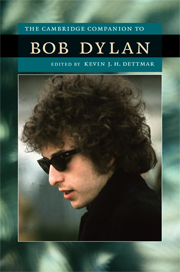Book contents
- Frontmatter
- Introduction
- Part I Perspectives
- Part II Landmark Albums
- 10 The Freewheelin’ Bob Dylan (1963)
- 11 Bringing It All Back Home (1965)
- 12 Highway 61 Revisited (1965)
- 13 Blonde on Blonde (1966)
- 14 The Basement Tapes (1967; 1975)
- 15 Blood on the Tracks (1975)
- 16 Infidels (1983)
- 17 “Love and Theft” (2001)
- Works cited
- Index
17 - “Love and Theft” (2001)
from Part II - Landmark Albums
Published online by Cambridge University Press: 28 May 2009
- Frontmatter
- Introduction
- Part I Perspectives
- Part II Landmark Albums
- 10 The Freewheelin’ Bob Dylan (1963)
- 11 Bringing It All Back Home (1965)
- 12 Highway 61 Revisited (1965)
- 13 Blonde on Blonde (1966)
- 14 The Basement Tapes (1967; 1975)
- 15 Blood on the Tracks (1975)
- 16 Infidels (1983)
- 17 “Love and Theft” (2001)
- Works cited
- Index
Summary
Leslie Fiedler, in a book whose title I riffed on for my Love and Theft: Blackface Minstrelsy and the American Working Class (a little bit of larceny in its own right), famously suggested that US narrative is continually possessed by the idea of two men, one white and one dark, alone together in the American void, Huck and Jim, Kirk and Spock, Dre and Eminem. The minstrel show's miscegenation in one body - the white man inhabiting black - literalized this imaginary proximity, the fascination with and heisting of black cultural materials. When Bob Dylan turned to “Jack Frost” to produce his great 2001 album “Love and Theft,” he generated another mask to handle the cultural mash he advanced, where, as he put it in an interview, the original influences are represented but not any more in their original form, like barley into whiskey. If Dylan's mash is a little sour, it's because it's so fully aged. Dylan could only have made this record at 60, not just because it showcases a ripped and ragged voice but also because of its incredible range, literary, musical, and philosophical. I'll argue here that in addition to its reflections on the musical relations of race and artistic borrowing generally - its theory of culture - Dylan's “Love and Theft” advances as well an intricately related musical theory of affective life in late middle age. If once he used “ideas as . . . maps,” he's older than that now, feeling his way, pledging his time, lyin' in winter, mapping his country ( ”My Back Pages,” Another Side of Bob Dylan, 1964).
- Type
- Chapter
- Information
- The Cambridge Companion to Bob Dylan , pp. 167 - 173Publisher: Cambridge University PressPrint publication year: 2009
- 4
- Cited by

